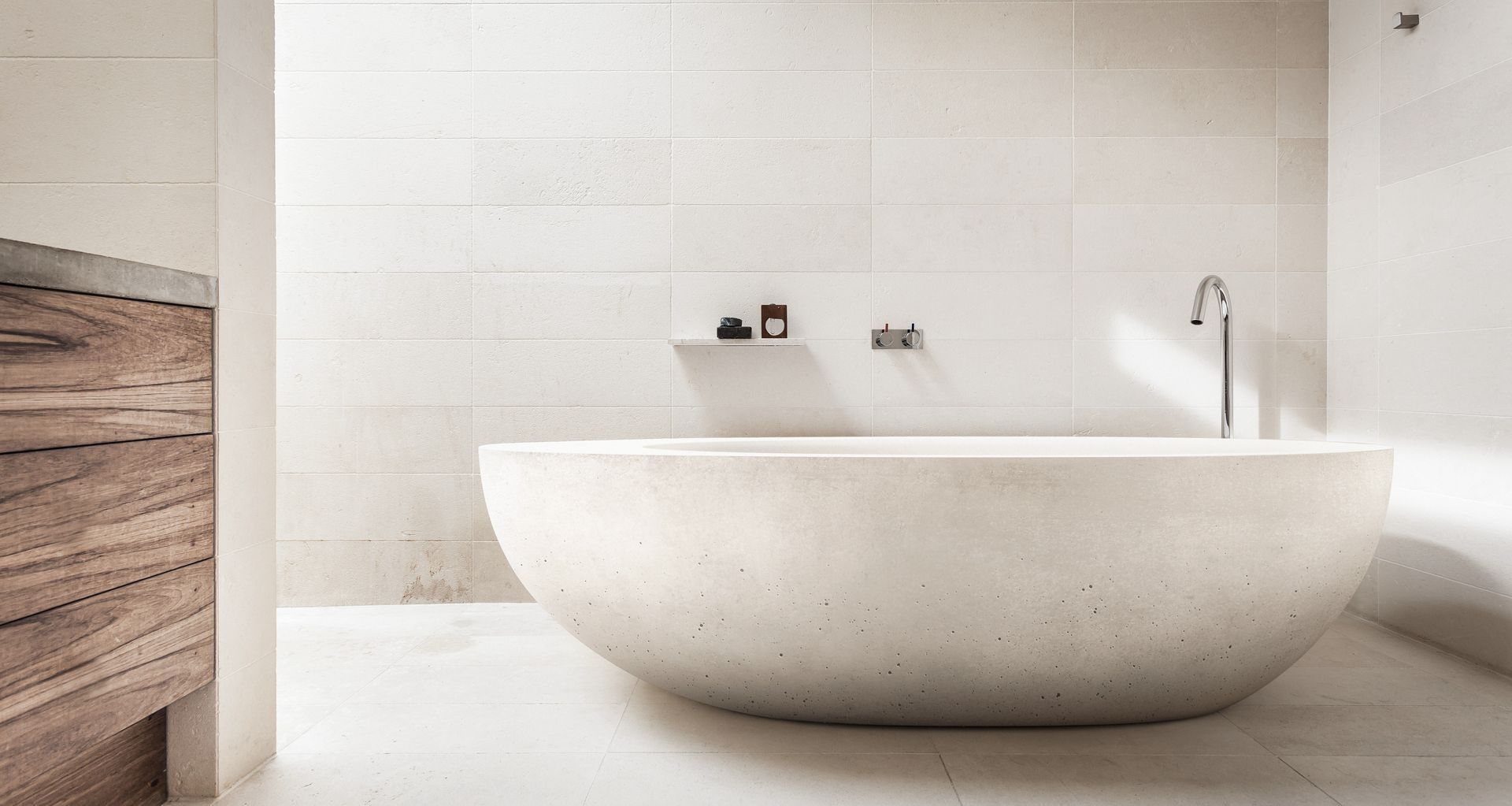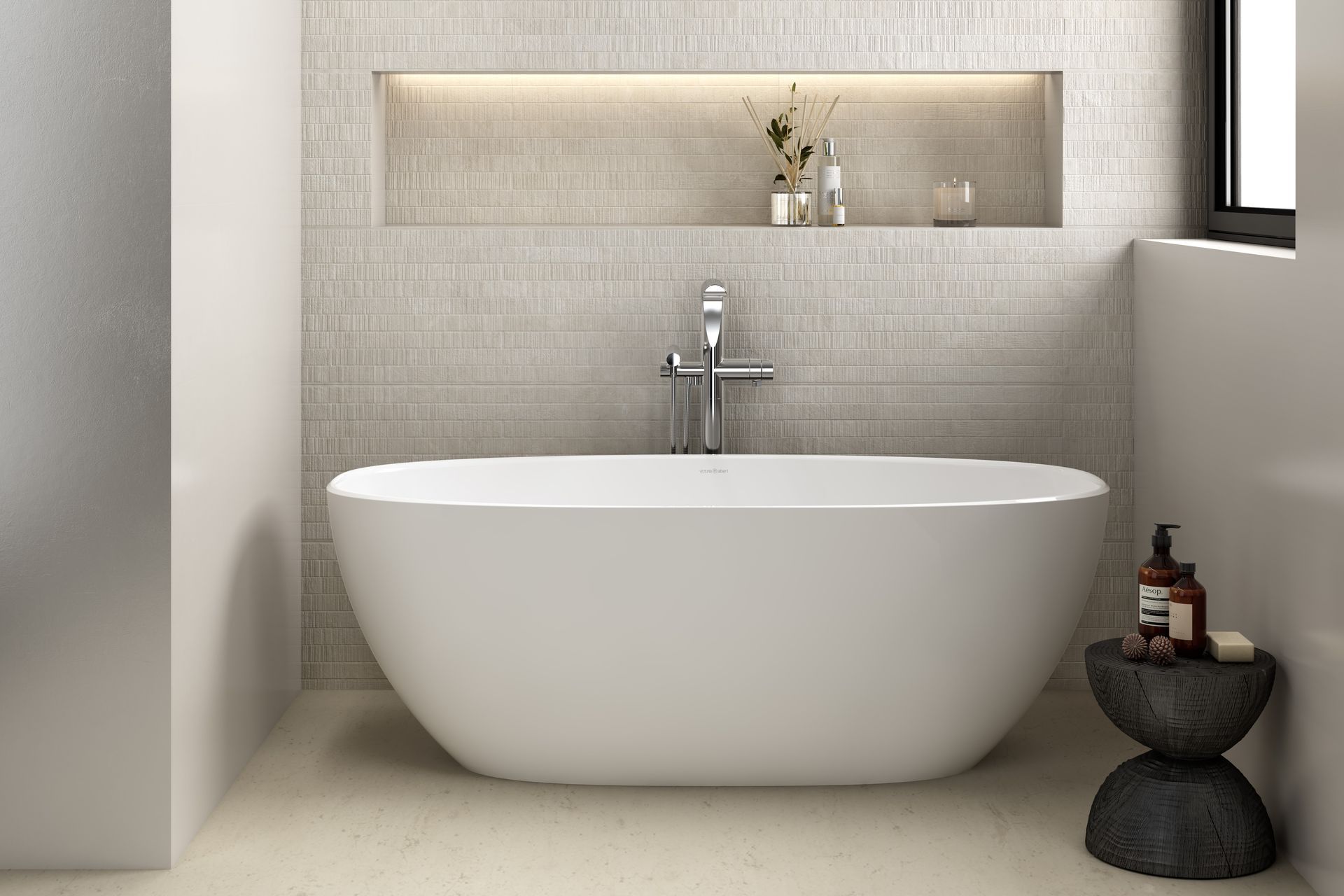Freestanding vs built in bath: which is best for you?
Written by
07 June 2023
•
10 min read

Freestanding and built in bathtubs both have a lot to offer as two of the most popular choices for homes in New Zealand today. The decision about which is best for you comes not from a direct comparison but from understanding the differences and thinking about them in the context of your needs and desires. In doing so, you’ll give yourself the best chance of picking the most suitable option that will do everything you need it to and more.

Pros and cons of freestanding baths
The freestanding tub is often seen as the luxurious choice, idealised by the classic cast iron claw foot bath and the thought of reclining in one in a state of total relaxation. This example touches on several benefits but there are a few things that may be considered drawbacks that you should also be aware of.
The advantages of freestanding baths
1. Experience and comfort — indulgence at its best
As just described, nothing quite matches the bathtub experience offered by a luxury freestanding bath. They have always been larger sized baths, not just in length but in depth as well, accommodating a deeper and more immersive soak. Many now also feature ergonomic designs with sloping backrests and a roll top style with curved edges for your neck and arms. This trait is perhaps the biggest appeal of the freestanding bathtub making a compelling case for itself from the outset.
2. Design and aesthetics — easy on the eye
Freestanding tubs are an aesthetically pleasing option, designed with the intention of being a focal point for the bathroom. There are also many different designs and styles available on the market allowing you to really customise your interior design and personalise it in a unique way. This can make it a real showstopper adding tremendous value to your home.

3. Ongoing maintenance — quick cleaning option
A freestanding bath is generally considered easier to clean as it is typically accessible from all sides without being attached to the bathroom walls or other furnishings. This is a point that shouldn’t be underestimated as the time spent cleaning is always a sour point. It will also prevent potential strains given you won’t have to reach as far to clean any particular side of the bath.
4. Design and installation — fantastic versatility
The fact a freestanding tub doesn’t have to be attached to a wall makes it an extremely versatile choice as it can be placed anywhere on the floorplan of your bathroom. This opens up all kinds of interesting design possibilities which can make for a very unique space. It also makes installation a little easier as it doesn’t need to be constructed around, compared to a built-in bath for example.
Related article: Bathtub sizes in New Zealand — making the right choice

The disadvantages of freestanding baths
1. Sizing and space — a tight fit for small spaces
As already mentioned, freestanding bathtubs are typically designed for indulgence which means they are often larger in size than alternative options. If your bathroom has a smaller footprint, then it might make for a tight fit. Even if it can physically fit, you might find that its presence makes a space feel smaller than it actually is if the bathroom isn’t large enough. There are some smaller sized options in the market so it isn’t completely impossible to pull off but something to be aware of all the same.
2. Upfront cost — a long-term investment
The average cost of a freestanding bath is generally higher compared to other types of baths given they are designed and manufactured as premium products using the finest materials and latest features. They typically start from about $1,000 but can go as high as $10,000 and sometimes more for the finest options. They are incredibly robust because of this with a lifespan of decades so the return on investment is strong but you will need to be able to meet the initial costs in the first instance.

3. Storage space — alternatives will be needed
Freestanding baths aren’t designed with storage in mind which can be included with some other types of tubs. Again, this is more of an issue if you have a smaller bathroom where space for storage comes at a real premium. For larger bathrooms, this will likely be a non-issue so it just depends on your specific situation.
4. Accessibility — challenging for some
The high sides of a freestanding bath can make it difficult for young children, the elderly or those with mobility issues to get in and out. The lack of a nearby wall in most cases also makes the placement of supportive rails difficult. An important aspect to bear in mind if it impacts members of your household.

Pros and cons of built in baths
Built in tubs, sometimes known as recessed baths or alcove baths, are those that are installed against walls or corners in a bathroom space. They are very functional and offer some interesting styling opportunities as well but do have some limitations that may not work for all.
The advantages of built in baths
1. Space efficiency — maximise your floor space
A built in tub is the perfect choice for utilising nooks and alcoves in a bathroom layout, frequently found in older homes though they can be designed into new ones as well. It frees up valuable floor space making it particularly appealing to those with a small bathroom. It makes the whole space feel more spacious, relaxing the mood and atmosphere at the same time.
2. Storage options — additional functionality
It’s no secret that storage space is incredibly important in a bathroom and many built in baths feature, or can be customised to include storage options. This makes them very enticing from a practical point of view and can help you quickly achieve a clean and clutter-free bathroom.

3. Cost-effective — affordable options readily available
There is a wide range of built in tubs available on the market in New Zealand, many of which are positioned at a very accessible price point. For example, you can find a built in acrylic bath for around $300 with premium choices around $2,500. There are a number of reasons for this lower pricing. One of the main ones is that fewer materials are required to manufacture them. The materials also don’t have to have the same decorative qualities as a freestanding bath as the exterior isn’t on show.
4. Style and customisation — potential for creativity
A built in bath almost presents a blank canvas for a bathroom designer or DIYer as the base is something that is constructed separately from the bath. This is usually done with some sort of panelling which can be customised in any number of different ways. Wall tiles are also a popular choice with again plenty of colours, patterns and design options to choose from.
Related article: Stunning bathtub surround ideas for Kiwi homes

The disadvantages of built in baths
1. Bathroom layout — limitations with placement
One of the limitations of a built in bathtub is that it has to be installed in and around walls with only a few viable options in any one bathroom space. If you want to explore different design possibilities, this can sometimes be a hindrance. If however you’re renovating an existing space, your hand might already be forced due to the current layout, in which case this won’t be a factor.
2. Design options — the differences are subtle
As the exteriors of built in baths aren’t designed to be seen, the demand for a wide range of designs isn’t as strong compared to freestanding baths. As such, you’ll find the differences between products, from a design perspective, are quite subtle. The big variations tend to be with the materials and finishes themselves.
3. Installation costs — additional work sometimes required
While the upfront costs of a built in bath can be lower, there is sometimes additional work required to complete the installation. This is especially true if an existing base does not already exist in the bathroom and has to be constructed from scratch. If you want to further customise the base with storage options, this can also add to the final bill you’ll end up paying.
4. Maintenance and repairs — harder access for professionals
With built in baths being installed into a constructed base, the plumbing becomes harder to access should problems arise. This could require the removal of panels and tiles which can be time-consuming and costly. Proper installation in the first instance should hopefully negate the need for this at most but over the long term, issues invariable arise so should be factored in.
Related article: 11 different types of bathtubs: pros and cons

Factors to consider when making your decision
With all the pros and cons of freestanding baths and built in baths extensively covered, the next thing to do is apply them to your own situation. When making a decision about any bath, there are some broad factors that need to be considered no matter what type of bath you’re looking at.
1. Your budget
Obviously, the money you have to spend on your new bathtub is a defining factor so you’ll need to set a budget and do your best to work within it. This of course includes the upfront cost of the bathtub itself as well as the installation costs of the plumbing professional for the work required. It’s crucial to get accurate quotes for both as you don’t want any unexpected surprises when it comes time to settle your bill. Also, factor the costs over the long term into your thinking. A cheap bathtub might appear good to start with, but if you need to replace it within a few years its overall cost could end up being much higher.
2. Space constraints
Space and the size of a bathtub is another important factor in the layout of any bathroom. This is crucial for a number of reasons including space utilisation, functionality and comfort, traffic flow, accessibility and aesthetics to name a few. It’s vital to pay attention to this carefully ensuring that your new bathtub will work within your bathroom and not become a hindrance to it. Your instinct will guide you in some sense on this but don’t hesitate to seek professional advice if required.

3. Design aesthetics
Often overlooked or given less significance, the design and appearance of your bathtub should also be given meaningful attention and consideration before any final decision is made. Though it may seem superficial to do so, the aesthetic of such a prominent feature will have a direct impact on the mood and ambience of your bathroom. Ideally, you want your bathroom to be a personal sanctuary in which you can unwind or get ready for your day ahead. A bathtub that jars against the interior styling of your space may unintentionally have the opposite effect so needs to be taken seriously.
Related article: Bath vs shower: water usage, cleanliness and other FAQs
Freestanding baths vs built in baths — the choice is yours
Having covered the ins and outs of freestanding baths vs built in baths and the criteria from which to make a decision, you’ll be able to quickly decide for yourself which is best for you. It’s an important part of your bathroom and your selection will dictate how you experience it on a day-to-day basis. So long as you think about it with these ideas in mind, you’ll have covered your bases, ensuring you end up with a bath that delivers in every way it should.
Explore an extensive range of high-quality bathtubs for your bathroom on ArchiPro